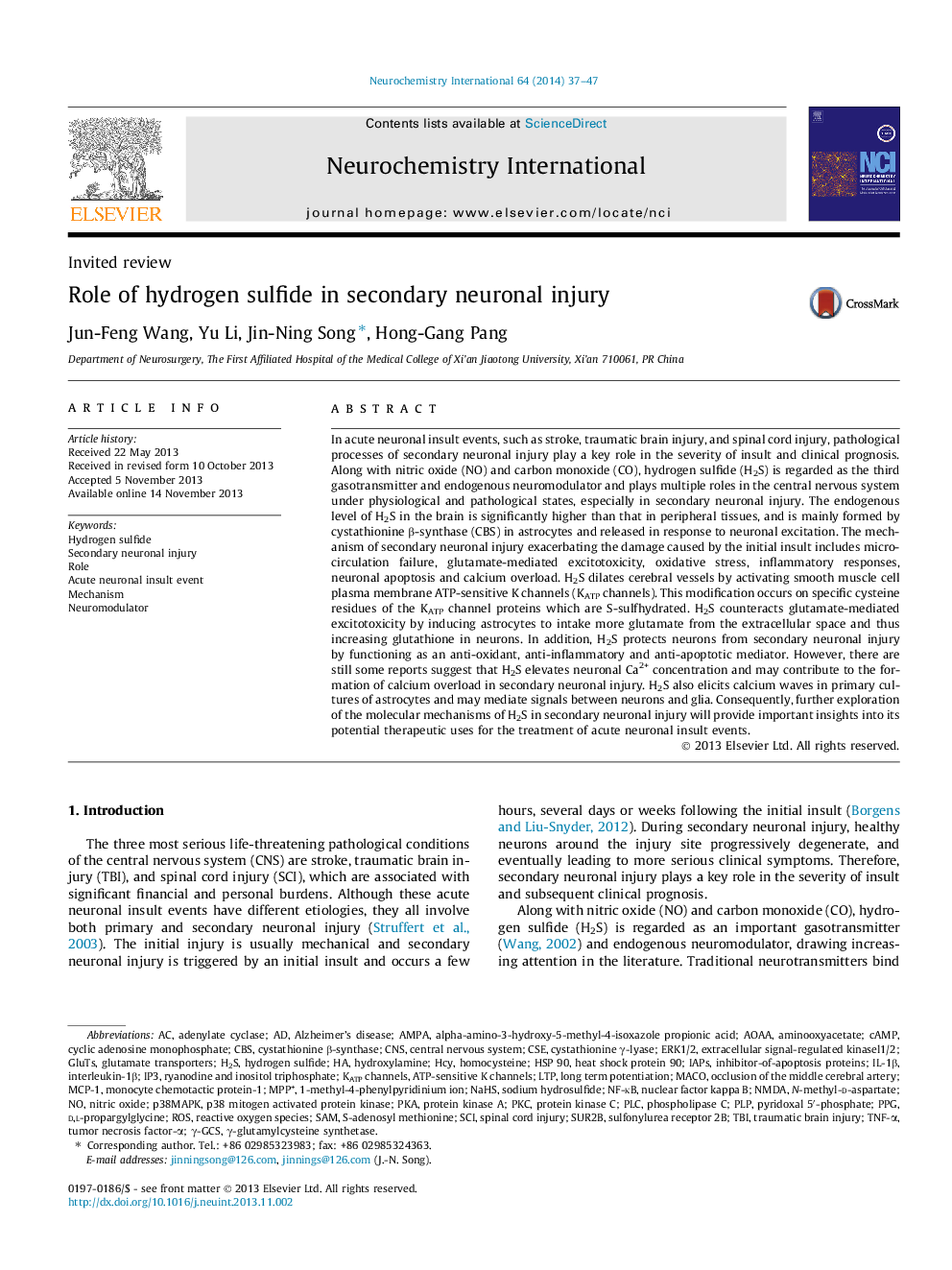| Article ID | Journal | Published Year | Pages | File Type |
|---|---|---|---|---|
| 8479269 | Neurochemistry International | 2014 | 11 Pages |
Abstract
In acute neuronal insult events, such as stroke, traumatic brain injury, and spinal cord injury, pathological processes of secondary neuronal injury play a key role in the severity of insult and clinical prognosis. Along with nitric oxide (NO) and carbon monoxide (CO), hydrogen sulfide (H2S) is regarded as the third gasotransmitter and endogenous neuromodulator and plays multiple roles in the central nervous system under physiological and pathological states, especially in secondary neuronal injury. The endogenous level of H2S in the brain is significantly higher than that in peripheral tissues, and is mainly formed by cystathionine β-synthase (CBS) in astrocytes and released in response to neuronal excitation. The mechanism of secondary neuronal injury exacerbating the damage caused by the initial insult includes microcirculation failure, glutamate-mediated excitotoxicity, oxidative stress, inflammatory responses, neuronal apoptosis and calcium overload. H2S dilates cerebral vessels by activating smooth muscle cell plasma membrane ATP-sensitive K channels (KATP channels). This modification occurs on specific cysteine residues of the KATP channel proteins which are S-sulfhydrated. H2S counteracts glutamate-mediated excitotoxicity by inducing astrocytes to intake more glutamate from the extracellular space and thus increasing glutathione in neurons. In addition, H2S protects neurons from secondary neuronal injury by functioning as an anti-oxidant, anti-inflammatory and anti-apoptotic mediator. However, there are still some reports suggest that H2S elevates neuronal Ca2+ concentration and may contribute to the formation of calcium overload in secondary neuronal injury. H2S also elicits calcium waves in primary cultures of astrocytes and may mediate signals between neurons and glia. Consequently, further exploration of the molecular mechanisms of H2S in secondary neuronal injury will provide important insights into its potential therapeutic uses for the treatment of acute neuronal insult events.
Keywords
NeuromodulatorIL-1βIP3NMDAN-methyl-d-aspartatePLCPKCIAPSGluTsHcyAOAAPLPCBSNaHSp38MAPKPPGHSP 90γ-GCS1-methyl-4-phenylpyridinium ionTBISUR2Bd,l-PropargylglycineMACOalpha-amino-3-hydroxy-5-methyl-4-isoxazole propionic acidAMPApKaMCP-1H2SCSESAMcAMPcystathionine γ-lyaseERK1/2MPP+NF-кBROSS-adenosyl methionineγ-glutamylcysteine synthetaseCyclic adenosine monophosphateadenylate cyclaseTraumatic brain injurySpinal cord injuryAminooxyacetateInterleukin-1βAlzheimer’s diseaselong term potentiationLTPtumor necrosis factor-αglutamate transportersCNSHydrogen sulfidecystathionine β-synthasecentral nervous systemsciTNF-αnuclear factor kappa Bphospholipase CMechanismRoleNitric oxidehomocysteineSodium hydrosulfideHydroxylamineMonocyte chemotactic protein-1Heat shock protein 90protein kinase AProtein kinase Cp38 mitogen activated protein kinasepyridoxal 5′-phosphateKATP channelsReactive oxygen species
Related Topics
Life Sciences
Biochemistry, Genetics and Molecular Biology
Cell Biology
Authors
Jun-Feng Wang, Yu Li, Jin-Ning Song, Hong-Gang Pang,
